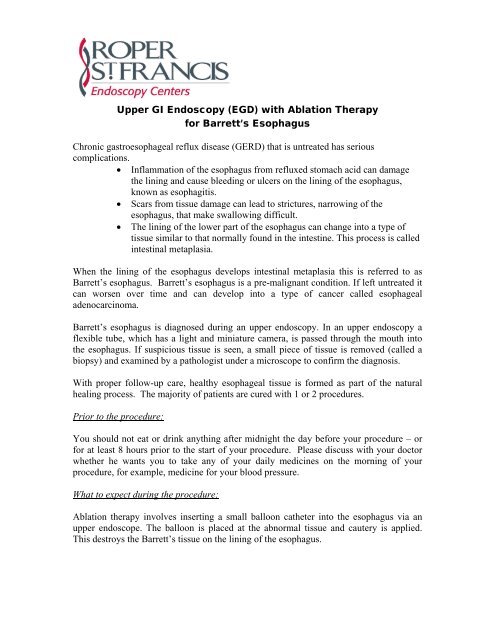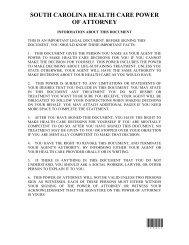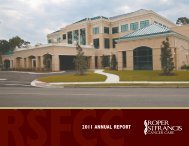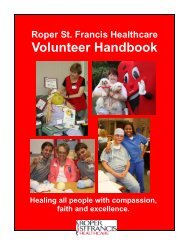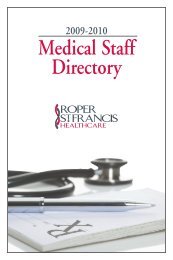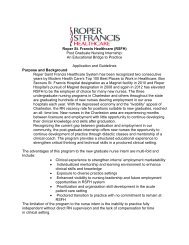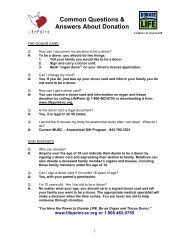Upper GI Endoscopy (EGD) with Ablation Therapy for Barrett's ...
Upper GI Endoscopy (EGD) with Ablation Therapy for Barrett's ...
Upper GI Endoscopy (EGD) with Ablation Therapy for Barrett's ...
Create successful ePaper yourself
Turn your PDF publications into a flip-book with our unique Google optimized e-Paper software.
<strong>Upper</strong> <strong>GI</strong> <strong>Endoscopy</strong> (<strong>EGD</strong>) <strong>with</strong> <strong>Ablation</strong> <strong>Therapy</strong><strong>for</strong> Barrett’s EsophagusChronic gastroesophageal reflux disease (GERD) that is untreated has seriouscomplications. Inflammation of the esophagus from refluxed stomach acid can damagethe lining and cause bleeding or ulcers on the lining of the esophagus,known as esophagitis. Scars from tissue damage can lead to strictures, narrowing of theesophagus, that make swallowing difficult. The lining of the lower part of the esophagus can change into a type oftissue similar to that normally found in the intestine. This process is calledintestinal metaplasia.When the lining of the esophagus develops intestinal metaplasia this is referred to asBarrett’s esophagus. Barrett’s esophagus is a pre-malignant condition. If left untreated itcan worsen over time and can develop into a type of cancer called esophagealadenocarcinoma.Barrett’s esophagus is diagnosed during an upper endoscopy. In an upper endoscopy aflexible tube, which has a light and miniature camera, is passed through the mouth intothe esophagus. If suspicious tissue is seen, a small piece of tissue is removed (called abiopsy) and examined by a pathologist under a microscope to confirm the diagnosis.With proper follow-up care, healthy esophageal tissue is <strong>for</strong>med as part of the naturalhealing process. The majority of patients are cured <strong>with</strong> 1 or 2 procedures.Prior to the procedure:You should not eat or drink anything after midnight the day be<strong>for</strong>e your procedure – or<strong>for</strong> at least 8 hours prior to the start of your procedure. Please discuss <strong>with</strong> your doctorwhether he wants you to take any of your daily medicines on the morning of yourprocedure, <strong>for</strong> example, medicine <strong>for</strong> your blood pressure.What to expect during the procedure:<strong>Ablation</strong> therapy involves inserting a small balloon catheter into the esophagus via anupper endoscope. The balloon is placed at the abnormal tissue and cautery is applied.This destroys the Barrett’s tissue on the lining of the esophagus.
A monitor will record your blood pressure, pulse, blood oxygen levels, as well as theheart rate and rhythm throughout the procedure. Your doctor will give you medicinethrough an IV to help you relax and be more com<strong>for</strong>table during the procedure.You’ll lie on your side, and your doctor will pass the endoscope through your mouth andinto the esophagus, stomach, and duodenum. The endoscope doesn’t interfere <strong>with</strong> yourbreathing. Most patients consider the test only slightly uncom<strong>for</strong>table, and many patientsfall asleep during the procedure.What to expect after the procedure:The procedure itself usually about 30 minutes; but, you should plan on being at thehospital <strong>for</strong> about two to three hours. This includes preparation and recovery time. Themedicine you receive may make it difficult <strong>for</strong> you to remember what the doctor ornurses tell you after your procedure. It is helpful to have someone <strong>with</strong> you who can alsohear the instructions and stay <strong>with</strong> you on the day of the procedure. You cannot operatemachinery or drive a motorized vehicle <strong>for</strong> 24 hours after the procedure. Please makearrangements <strong>for</strong> someone to be at the hospital to take you home. In addition:Most patients experience mild soreness or discom<strong>for</strong>t after the procedure. Thesesymptoms are typically controlled <strong>with</strong> standard pain medication and usually lasta day or two.Patients eat a full liquid diet <strong>for</strong> 24 hours then progress to a soft diet <strong>for</strong> severaldays.<strong>Ablation</strong> therapy does not cure GERD. Since acid reflux is the likely cause ofyour Barrett’s, it is crucial that you control your reflux to prevent a recurrence ofBarrett’s. Your doctor may recommend additional medications to further controlyour GERD and regular checkups will be required to monitor your condition.Please see <strong>EGD</strong> <strong>with</strong> Cautery Discharge Instructions in the Patient Resources section ofthis website.


